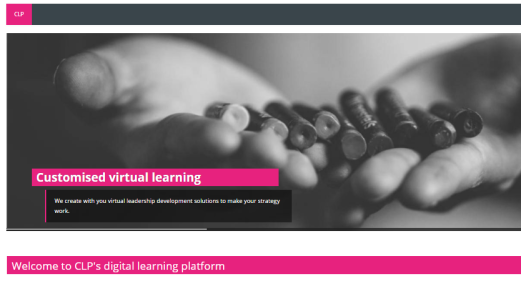
Share this article
This issue is based on an interview with Dr Marcus Gottschalk, CEO and Ms. Giulia Colafrancesco, Junior Consultant at CLP, about eLearning and CLP’s digital solutions.
Giulia: Why is CLP offering a digital learning solution to its clients?
Marcus: We are entering very exciting times that will change the corporate executive learning industry forever. Over the last 20 years, the industry has concentrated on face-to-face learning solutions for leaders. Entering the digital age, we are seeing a rise in digital learning formats.
G: What is digital learning? Can you explain?
M: We have seen in recent years an increased use of webinars, virtual meetings (using platforms like WebEx and Skype for Business) and the rise of online courses like MOOCs (massive open online courses). Additionally, we can see an increased offering in eLearning solutions to programme online courses like Moodle, Edmodo or EDUonGo. I think digital communication and learning becomes popular as organisations realise their advantages.
G: What are the advantages of digital learning?
M: We can see many individual as well as organisational advantages. Individual advantages are surely that learning can be personalised: how fast and the way we learn. Organisational advantages are price and speed. It is much cheaper to create online learning formats that are used by many leaders. Online formats are scalable; these formats can be changed fast, so that they are always up to date. For example, CLP has its own film studio. Here, we can shoot educational mini-clips overnight. The content is always customised and up to date.
G: Ok, give me a concrete example of an eLearning course you offer.
M: We started last year with ePGC, which stands for electronic peer-group coaching. Traditional peer-group coaching brings together peers (leaders usually from one organisation and the same hierarchy but not necessarily colleagues) that coach each other on business and personal issues without the support of an expert external facilitator or coach. So basically, in class, we train participants on the process of how to conduct PGC and the necessary coaching skills. Then, without external intervention, peers meet and help each other, using a well-defined frame.
Today, we are able to offer the same approach virtually. Participants will be matched and groups formed. On our eLearning platform they can find all information to professionally conduct PGC in the form of various video casts, quick reads, pocket guides for downloads, and a chat activity for exchanges with peers and the trainer. CLP is able to monitor progress and receives instant participant feedback though an online questionnaire function. In this example, we can see the power of eLearning solutions. Participants are guided for learning but don’t have to travel and sit in a classroom listening to trainers and consultants; still they come together for social and collaborative learning.
CLP is constantly evolving leadership development practices. CLP publishes 500 words periodically that reflect its experiences and research, and those of other organisations to understand and master the challenges and demands of leadership development today. We are excited to hear about your experiences. Please share your thoughts, concerns or examples with us at: 500words@change-leadership.net
G: What are the other eLearning courses or approaches that you offer?
M: Currently, next to ePGC, we offer an easy and fast-to-use online diagnostic that provides intact teams with immediate feedback about needs, strengths and critical team performance data. Also, we offer a course on leading change that guides leaders through customised change theory, and that offers specific change tools and loads of tips. This course is built differently from the aforementioned one as it works with micro-content that is viewed by participants daily. Often organisations need to offer one single-change approach to its leaders to create one common organisational language, usage and culture. With this digital change solution, we can help to establish exactly that. Next to these semi-standardised courses, CLP’s real strength is the capability to customise eLearning courses according to our clients’ needs and specifications.
G: What do you mean? How do you customise eLearning to clients’ needs?
M: It is best to explain that with an example. One of our clients needed to cut costs and travel time for participants as well as to cut classroom time for their leaders for various reasons. They asked CLP if we could transform a four-day face-to-face module on organisation development and culture into a comprehensive digital solution. And that is what we did. This eLearning course offers now content loaded mini video-clips, virtual peer-group sessions around culture, online exercises, questionnaires and virtual group supervisions. We stretched the previously four classroom days into 6 months, so that participants are able to implement content into their daily working life, test it and come back with questions for reflection.
Thank you Marcus for this interview.
Yours,
Giulia Colafrancesco and CLP team